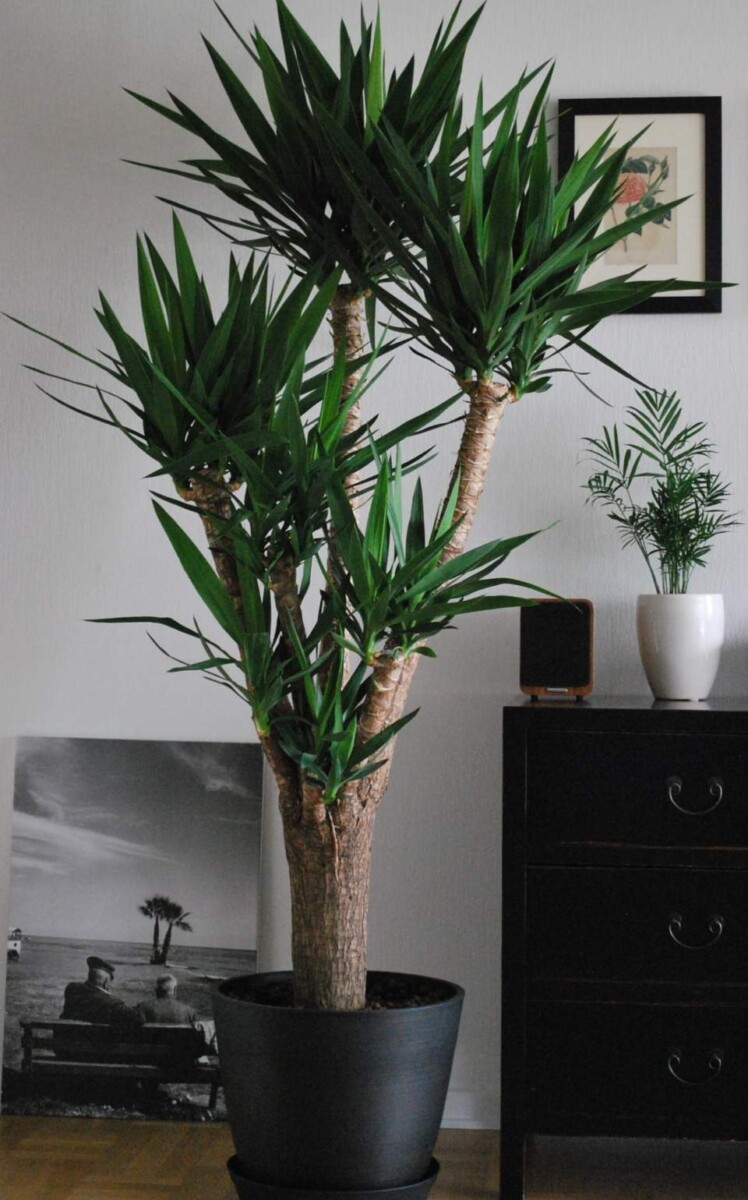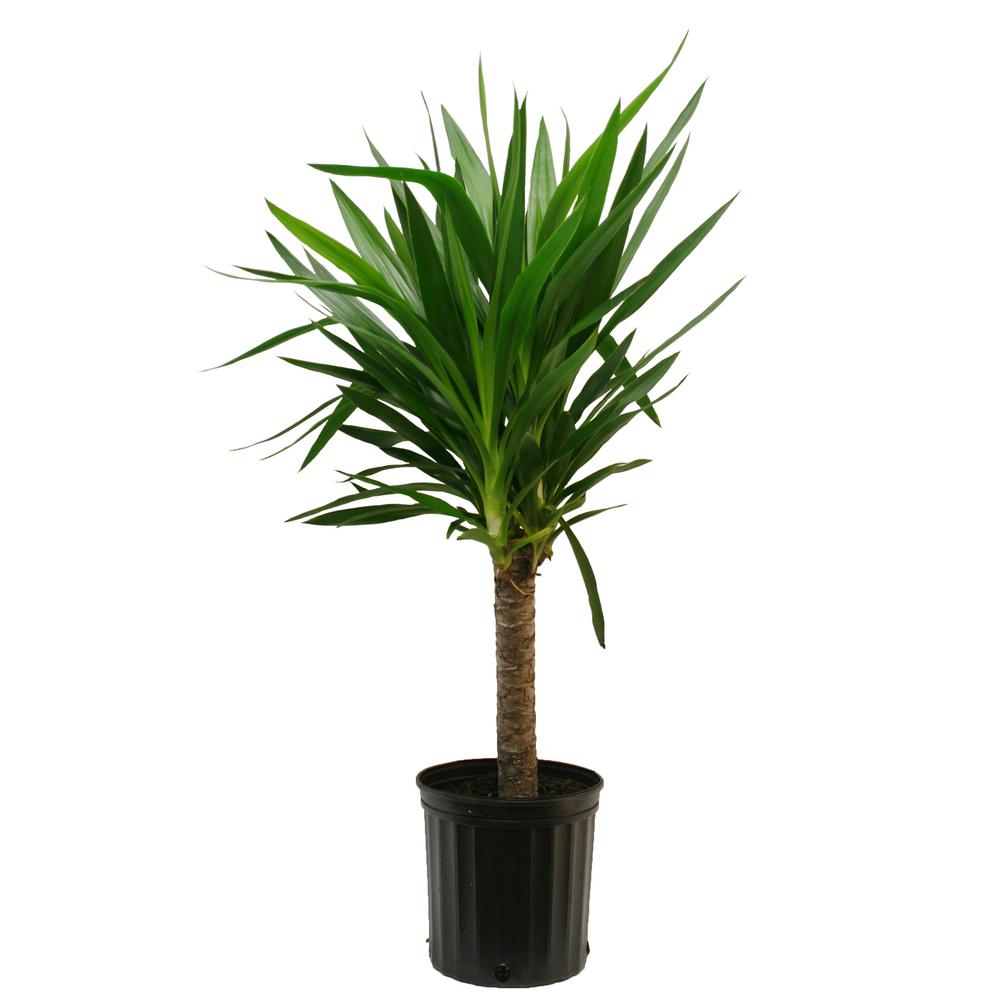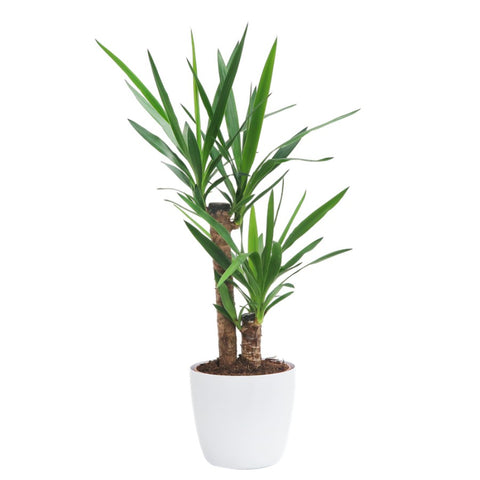Yuccas are drought tolerant plants, therefore between waterings, the top 2.5 inches of the soil must completely dry out. Always give yucca a good soak so that the water drains out the pot’s drainage holes. Generally speaking, watering should be done every 14 days or so, however this depends on the climate.
To determine the best watering schedule for yucca plants based on your particular indoor environment and conditions, keep reading.
Table of Contents
How Often to Water Yucca Plants (Indoors)
Native to Mexico and the South West of the United States, yuccas are drought-resistant plants that thrive in dry deserts, rocky badlands, and hilly regions with well-draining soil and intermittent rainfall.
The thick, fleshy roots of yucca plants, which retain water from intermittent rainfall, and the oily coating on their leaves, which lessens water loss (transpiration) from the leaves, are adaptations to their desert surroundings.
The main mistake with watering yuccas is always watering too frequently, which causes the leaves to become yellow and droop as a symptom of stress with root rot being a regular problem. Yuccas are so well suited to thriving in dry soils without much moisture.
By keeping the soil on the dry side rather than overwatering, you can effectively produce yucca trees by mimicking the soil’s natural watering and drainage patterns.
Before watering yucca plants, the top 2.5 inches of the soil must feel dry to the touch. This usually entails watering yucca plants every 10 to 14 days, though this can change depending on the climate.
But how frequently you water is determined by how soon the top 2.5 inches of soil dry out. This may change because of
- humidity in your environment (higher humidity requires less frequent watering).
- How big the pot is (small pots dry out much quicker).
- Whether your yucca is near a heat source, forced air, air conditioning, or another air current (air currents sap more moisture for the leaves).
- The soil’s ability to hold onto moisture (yucca requires well draining soil).
Feel the soil to a finger’s depth to determine how frequently to water your yucca plant in accordance with your unique conditions.
Do not water if you still feel moisture in the soil; nevertheless, if the earth feels a little dry, now is the ideal time to water.
With some expertise and careful soil monitoring, you can pinpoint the exact moment when your soil begins to dry out and develop the ideal watering regimen for your houseplant yucca.
The cycle of drought followed by a downpour of rain in the yuccas’ natural environment is replicated by the frequency of watering.
How to Tell if you are Watering your Yucca too Often or not Enough…
The leaves of yucca begin to yellow and droop if you are watering it too regularly, which is a sign of water stress.
Yucca enjoy arid environments, making them particularly vulnerable to water stress and root rot.
(Read my article Why are my yucca leaves turning yellow for tips on how to resuscitate your overwatered plant.)
The leaves of yucca begin to droop, curl, and may even turn brown if you do not water them frequently enough or too lightly.
If so, it’s crucial to water more regularly and to give your plants a deep soak each time.
A parched plant pot should ideally be submerged in a basin of water for 20 minutes so that the soil can soak up enough of water and the yucca can replenish the water reserves they have saved in their roots.
The yucca should recover after two or three rounds of watering at the recommended frequency.
Due to their innate resistance to drought conditions, yuccas are always easier to revive than other plants when they are overwatered.
(Read my essay on how to save a yucca plant from extinction.)
How Much to Water Yucca Plants
The quantity of water should remain constant, even though there are a lot of factors that affect how frequently to water your yucca.
Give yucca plants plenty of water until you can see water dripping from the drainage hole in the pot’s bottom.
In order for the roots to efficiently absorb the hydration they need, this makes sure that the water has permeated the soil and reached them.
Giving your plants enough of water can help encourage healthy root growth, which will strengthen their tolerance to drought.
If you water yucca too lightly, only the top inch or so of the soil will be moist, and the water will not seep into the soil and reach the roots of the plant, leading to drought-like signs including drooping, curling, and brown leaves.
The normal conditions in the yuccas’ original environment, which consist of a big downpour of rain followed by a period of dry weather and high temperatures, are likewise replicated by watering with a good soak.
Well Draining Soil Mitigates Over Watering
In order to properly prevent root rot, your yucca has to receive the proper amount of water in addition to the proper well-draining soil mix.
For a drought-tolerant plant like the yucca, conventional potting soil without sand or grit holds too much moisture around the roots, which can cause the leaves to turn yellow and foster the conditions for the roots to rot.
Peat-based potting mixtures are also inappropriate because, when it dries up, peat turns hydrophobic (repulses water), which prevents water from penetrating the soil effectively and instead causes it to run off the soil’s surface and out the bottom of the pot.
This may give the appearance that you are watering your yucca properly because water is leaking out the bottom of the pot, but the liquid has not actually gotten to the roots.
It’s critical to replicate the soil properties of the yucca’s original habitat in order to maintain the health of your plant.
In order to encourage adequate drainage, horticultural sand or grit should be added to the soil where your yucca will grow.
For the best drainage qualities for yucca, mix potting soil evenly with around 30% by volume of grit.
Since it has comparable drainage characteristics to cactus and succulent soil, it can also be used to grow yucca, but it is typically significantly more expensive than regular potting soil and grit.
It is much simpler to maintain the ideal moisture balance for yucca to avoid root rot and keep the plant healthy when the soil is good.
Use a Pot With Drainage Holes in the Base
One of the best ways to make sure your yucca has been properly hydrated so that moisture reaches the roots and maintains the plant’s health is to water until extra water trickles out the base of the container.
Without holes, water will pool around the roots of your yucca plant, which will cause root rot and eventual death.
Your potted yucca may still have water collecting around its roots if:
- The trays and saucers under the pot are not cleared. Trays are frequently placed beneath the pots of yucca plants to prevent water from pouring inside. The tray needs to be frequently drained of water because else the soil may remain moist enough to cause the yucca roots to rot.
- Drainage may be slowed by roots or compacted soil. If you notice that your pot’s water is draining slowly, check the drainage hole to make sure it hasn’t clogged up, preventing water from draining properly.
Key Takeaways:
- Give yucca plants a generous soak to the point where water drips from the bottom of the pot. To prevent root rot, water plants only when the top 2.5 inches of soil are completely dry in between applications. Make sure to remove any extra water from the tray under the pot.
- Yucca should be planted in a potting mix that drains well and has been grated to assist drainage.
- To avoid water accumulating around the roots and leading to root rot, always grow yucca in containers with drainage holes at the bottom.
- Overwatered yucca leaves turn yellow, while underwatered yucca leaves droop and curl before eventually becoming brown.
FAQ
How do you bring a yucca back to life?
After a good soak in water and frequent misting, yucca plants should start to recover since they can withstand drought well. The yucca should begin to recover after a few cycles of watering (wait until the top 2.5 inches are dry between bouts of watering).
What can I do to yucca leaves when they turn yellow and brown end?
Simply put them in the shower and give them a mild water wash to remove the leaves and thoroughly soak the soil. Since yuccas are extremely hardy and you shouldn’t really harm the leaves, you shouldn’t worry too much about maintaining low water pressure.
How often should I water my indoor yucca plant?
Yuccas are drought tolerant plants, therefore between waterings, the top 2.5 inches of the soil must completely dry out. Always give yucca a good soak so that the water drains out the pot’s drainage holes. Generally speaking, watering should be done every 14 days or so, however this depends on the climate.
Can you overwater a yucca?
Due to root rot brought on by overwatering, yucca plants’ leaves turn yellow and droop. If the potting soil for yucca plants is too wet, the extra moisture depletes the soil’s oxygen supply, preventing root respiration and resulting in yellowing and drooping yucca leaves.
How do I stop my yucca from dying?
In order to avoid appearing withering, yuccas like to grow in brighter light or with some direct sunlight. (A yucca should not be moved from partial shade to full sun right away; otherwise, the leaves will scorch and become brown.) The leaves of yucca plants will also wilt if they are not given enough water or if it is applied too sparingly.



